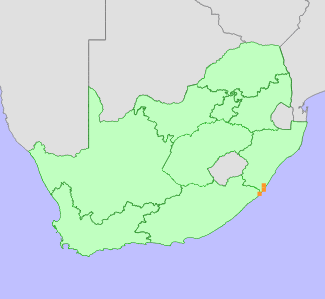|
Scientific Name | Eriosema luteopetalum C.H.Stirt. |
Higher Classification | Dicotyledons |
Family | FABACEAE |
National Status |
Status and Criteria | Vulnerable B1ab(ii,iii,iv,v)+2ab(ii,iii,iv,v) |
Assessment Date | 2020/12/02 |
Assessor(s) | H. Mtshali & K. Grieve |
Justification | This species is endemic to the KwaZulu-Natal Province of South Africa. It has a narrow distribution from Port Shepstone to Port Edwards, with an estimated extent of occurrence (EOO) of 190-270 km², and an area of occupancy (AOO) of 34-48 km². This species was historically described as locally abundant at collection sites, however as a result of habitat loss it now remains at between eight and 10 locations. The population continues to decline due to ongoing habitat loss and degradation. It is therefore listed as Vulnerable under criterion B. |
Distribution |
Endemism | South African endemic |
Provincial distribution | KwaZulu-Natal |
Range | It is endemic to southern KwaZulu-Natal, and is known from between Port Shepstone and Port Edward. |
Habitat and Ecology |
Major system | Terrestrial |
Major habitats | Pondoland-Ugu Sandstone Coastal Sourveld, KwaZulu-Natal Coastal Belt Grassland |
Description | It is a grassland species that occurs along the coast on sandy soils. |
Threats |
| About 66% of E. luteopetalum habitat is already irreversibly modified. Where collections have previously been made around Port Shepstone and Margate, there has been conversion of habitat due to urban development and expansion of agriculture. Loss continues with 19% of loss taking place between 1990 and 2014. Elsewhere in this species' range, declines in habitat quality is continuing due to the invasion of grasslands by alien plants. One subpopulation along R61 was extirpated due to the use of herbicides. |
Population |
Stirton (1986) indicated that this species is locally abundant in coastal grasslands and has been rarely collected. However, recent records indicate that it is now rare due to loss of habitat. It has been recorded in two provincial nature reserves (Mbumbazi and Skyline) and the Kongweni conservancy area. While it is difficult to estimate the overall size of the population the area of habitat is declining, and thus the population size is inferred to be declining.
|
Population trend | Decreasing |
Assessment History |
Taxon assessed |
Status and Criteria |
Citation/Red List version | | Eriosema luteopetalum C.H.Stirt. | Least Concern | Raimondo et al. (2009) | | Eriosema luteopetalum C.H.Stirt. | Lower Risk - Least Concern | Scott-Shaw (1999) | |
Bibliography |
Raimondo, D., von Staden, L., Foden, W., Victor, J.E., Helme, N.A., Turner, R.C., Kamundi, D.A. and Manyama, P.A. 2009. Red List of South African Plants. Strelitzia 25. South African National Biodiversity Institute, Pretoria.
Scott-Shaw, C.R. 1999. Rare and threatened plants of KwaZulu-Natal and neighbouring regions. KwaZulu-Natal Nature Conservation Service, Pietermaritzburg.
Stirton, C.H. 1986. The Eriosema squarrosum complex (Papilionoideae, Fabaceae) in southern Africa. Bothalia 16(1):11-22.
|
Citation |
| Mtshali, H. & Grieve, K. 2020. Eriosema luteopetalum C.H.Stirt. National Assessment: Red List of South African Plants version 2024.1. Accessed on 2025/11/11 |
 Comment on this assessment
Comment on this assessment


